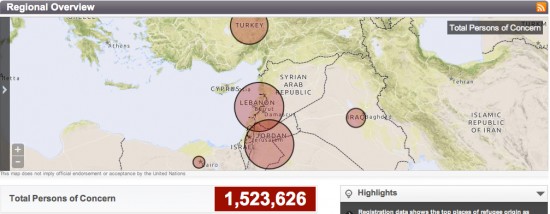Scenario rationale and explanation
The diplomatic talks fail and the international conference in Geneva does not take place or is a face-saving sham (see “Scenario 1: Peace in Geneva?” and its sub scenarios for what could result from a true international conference).
Considering the current forces on the ground and their balance, we would face a lengthening conflict (probably over years rather than months) with rising prospects of regional and global involvement and chaos. The scope and depth of regional and global spill over would increase with the duration of the Syrian civil war, and, in turn, fuel it.
The spill over and contagion would most probably take four shapes (not mutually exclusive). First, we would face any action ranging from covert operations to war-like actions to war between states (all probably escalating towards wars). This aspect, in its less intense forms, is actually already operating, although the states involved are very cautious not to cross the line (in terms of official statement and language) that would force them into war, as shows, for example, the two Israeli raids on Syria and the way they are reported (among others, see the US apology for confirming Israeli strikes – Jerusalem Post 19 May 2013) . The political part of this spill over is being continually enacted, reminding us of Von Clausewitz famous “War is the mere continuation of politics by other means.” Second, we would face a similar range of actions but between states and actors dubbed “non-state actors,” yet vying for state power). Those two forms of contagion are usually imagined or expected as occurring within the Middle East, lately enlarged to the Middle East and North Africa (MENA). This is however too narrow a view, as Russia reminded us on 17 May 2013 when it sent “at least 12 warships to patrol waters near its naval base in Tartous, Syria.” (Times of Israel, 17 May 2013) to underline the importance of its interest in Syria and in the region, as underlined, for example by Eldar (AlMonitor, 19 May 2013). The American debate over the type, value and wisdom of an American involvement in Syria is another obvious example of the way the Syrian conflict spills over beyond the region.
Third, countries welcoming Syrian refugees (1,52 million people on 20 May 2013 – UNHCR – see detailed map below) will face a risk of destabilization stemming from the massive influx of people in countries that were not prepared for them, and were already sometimes facing difficult situations. Furthermore, refugees may be linked to fighting units and carry on activities linked to the Syrian war in the host country, thus heightening the risk of seeing those countries dragged into the conflict. Those factors and resulting tensions are already at work, notably in Lebanon (e.g. Euronews 18 May 2013), Jordan (e.g. C. Phillips, The World Today, Volume 68, Number 8/9), Turkey (e.g. Ibid., Krohn, The Atlantic, 17 May 2013).
A fourth, more unconventional, form of contagion must also be considered. As the crisis lengthens in Europe, European individuals attracted to Salafi-jihadi would increasingly travel to and from Syria (see ICSR Insight, April 2013), heightening not only the direct threat of terrorism within Europe (Europol TE-SAT 2013: 7, 20, 24) and possibly in the U.S. and Canada but also the spread of Salafi-jihadi cells. Considering the crisis and the “fragilising” policies of austerity and “externalization” – i.e. privatization of the state – (especially those concerning the legitimate monopoly of violence), actions by Salafi-jihadi cells could heighten the risk of polarization, for example by favouring further the rise and strengthening of already spreading right-wing extremist movements. Crisis-related unrest could be a favourable environment for violent actions from Salafi-jihadi cells, that would then feed into a more generalized political turmoil. The spread of Salafi-jihadi ideology in countries hit not only by the crisis but also by a lack of hope and vision as well as by denial – whatever the hardship and dangers faced by citizens – is not to discard. In this light, the novel vision promoted by the new Pope Francois 1st, warning against “the cult of money and the dictatorship of an economy which is faceless and lacking any truly human goal” (Squires, The Telegraph, 16 May 2013) might be considered as a potential counterweight.
Similar heightened risks would exist for any country where nationals have found their way to fight in Syria, as for example, Tunisia (Sgrena, IPS, 6 April 2013), and increase with the fragility of the domestic political situation.
Until a real peace takes hold in Syria (and this is thus true too for scenarios 1.1.2. and 1.2.2., see previous post), it will be most necessary to use all anticipatory intelligence or strategic foresight and warning means, foreign policy instruments, and, ultimately, military intervention (which may also be seen as a de facto spill over of the conflict), to try preventing further spill over of the Syrian civil war, assuming this is still possible.
In scenarios 1 and 2, the efficiency of the support provided to the National Coalition for Syrian Revolutionary and Opposition Forces will need to be intensely monitored, and aid – lethal and non lethal, official and covert – will have to be steered according to results and potential consequences. In scenario 1, this specific aid, as well as all support (see state of play, part I, II, III) given to specific parties should disappear once a peace agreement is signed. In scenario 2, all aid will need to be monitored in the framework of the types of involvement chosen by the various international actors.
Estimating Likelihood for Scenario 2
What could enhance the likelihood to see such a scenario happening? Events happening currently in the MENA region – and beyond – as well as on the Syrian battlefield must also be read with this dimension in mind. The potential spoilers below must be seen as related and most of the time feeding into each other.
- It is finally impossible to find a solution that would be acceptable to all permanent members of the UN Security Council.
- Crucial international actors seek to extract too many advantages from other nations – related or unrelated to the region – and diplomatic talks fail.
- Events surrounding the Syrian issue, be it on the battlefield or internationally, finally derail the diplomatic talks by prompting the withdrawal of too many important (because of their involvement with and in Syria or because of their power) international actors. For example, the 15 May 2013 UN General Assembly adoption of the text “condemning violence in Syria, demanding that all sides end hostilities” was judged by both China and Russia as unhelpful, but it may also be read, as underlined by Nashashibi (AlArabyia, 20 May 2013) as an effort to stress the importance of a peaceful solution to the conflict, of “effective representative interlocutors for a political transition,” and thus of the necessity of an international conference. It is also possible that the terror attack in the Turkish town of Reyhanli is part of an effort to derail diplomatic talks (e.g. Seibert, DW, 14 May 2013).
- It is impossible to bring the regime of Bashar al-Assad to the negotiation table. Similarly, if it were impossible to find a person to represent the regime of Bashar al-Assad that would be acceptable to all parties, then, the international conference could not take place, or, if it were still happening, it would most probably only be a sham, i.e. all parties would not be represented or those accepting to sit at the negotiation table would not be representative of what is happening on the ground.
- A major surprise occurs that would change the international outlook on Syria and the war.The diplomatic talks could be terminated.
Evolutions for Scenario 2
Scenario 2 should lead either to Scenario 1 or to Scenario 3 (A real Victory in Syria, forthcoming). The main challenge we are facing here, as analysts, is to determine when one or the other will become likely or more likely. The timeline will depend upon what happens under the fog of war, knowing that the thicker the fog, the heightened the possibility for surprise. We shall thus have to constantly monitor the war situation, and, accordingly, revise – and improve – all possible scenarios. For example, a potential break up of Syria would then also have to be included as sub-scenario (for Scenario 1 and Scenario 3).
Scenario 2 could also, theoretically, lead to a Scenario 4, the invasion and annexation of Syria by an external power. However, considering the current international norms and settings, such a scenario is most unlikely and may be put aside. Should those norms change, or should the current international tension and crises bring about severe upheavals, then the likelihood of scenario 4 would have to be revised and the scenario developed. We may note an unintended side-effect stemming from the international ban on war for conquest. If it improved greatly peace and stability, it also tends to remove an incentive on domestic actors to stop civil war: the warring factions do not risk to see an external actor use the fragility brought about by civil war to annex their territory, thus they can continue fighting.
Scenario 3: A Real Victory in Syria
———-
Detailed bibliography and primary sources forthcoming.




